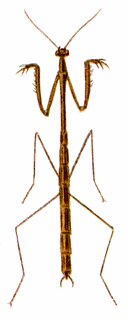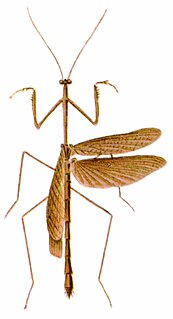
Mantis shrimp, or stomatopods, are carnivorous marine crustaceans of the order Stomatopoda, branching from other members of the class Malacostraca around 340 million years ago. Mantis shrimps typically grow to around 10 cm (3.9 in) in length, while a few can reach up to 38 cm (15 in). A mantis shrimp's carapace covers only the rear part of the head and the first four segments of the thorax. Varieties range in colour from shades of brown to vivid colours, with more than 450 species of mantis shrimp being known. They are among the most important predators in many shallow, tropical and subtropical marine habitats. However, despite being common, they are poorly understood, as many species spend most of their lives tucked away in burrows and holes.

Thesprotia graminis, the American grass mantis or grass-like mantis, is a species of mantis native to the Southern United States. It is found in Florida and Georgia. This species can reproduce parthenogenetically or through sexual reproduction. T. graminis is similar in appearance to Brunneria borealis.
Aethalochroa ashmoliana, common name Iranian stick mantis, is a species of praying mantis found in India, Iran, Pakistan, and Sri Lanka.
Aethalochroa insignis, common name Indian stick mantis, is a species of praying mantis found in India that was originally identified as a variety of A. ashmoliana.
Paratoxodera cornicollis, common name giant Malaysian stick mantis, is a species of praying mantis found in Malaysia and Indonesia.
Paratoxodera meggitti is a species of praying mantis found in China and Myanmar.

African mantis and African praying mantis are common names for many species of praying mantis native to Africa.

Sphodromantis is a large genus of praying mantises concentrated in Africa, sometimes considered a synonym of the genus Hierodula: from the same tribe, Paramantini. Outside their range especially, many share the common name African Mantis.
Eremiaphila pierrei, common name Pierre's mantis, is a species of praying mantis found in Algeria.
Eremiaphila persica is a species of praying mantis found in Turkey, Iran, and Azerbaijan.
Eremiaphila typhon is a species of praying mantis, native to Africa and Asia.
Pyrgomantis jonesi, common name Jones' mantis, is a species of praying mantis found in Burkina Faso, Ghana, Cameroon, Nigeria, Niger, and Senegal.
Pyrgomantis bisignata, common name Jones' mantis is a species of praying mantis found in the Congo River region.
Pyrgomantis nasuta is a species of praying mantis found in Angola, Cape Province, Cameroon, Kenya, Natal, Namibia, Somalia, and Tanzania.
Pyrgomantis signatifrons is a species of praying mantis found in the Congo River area.
Pyrgomantis singularis is a species of praying mantis found in Kenya, Natal, Tanzania, and the Transvaal.

Thesprotia is a genus of mantises commonly known as grass mantis. They are native to the Americas and are represented by the following species:
Thesprotia filum, the grass mantis, is a species of mantis found in French Guiana, Surinam, and Trinidad.

Paralygdamia madagascariensis is a species of praying mantis native to Madagascar.

Mantises are an order (Mantodea) of insects that contains over 2,400 species in about 460 genera in 33 families. The largest family is the Mantidae ("mantids"). Mantises are distributed worldwide in temperate and tropical habitats. They have triangular heads with bulging eyes supported on flexible necks. Their elongated bodies may or may not have wings, but all Mantodea have forelegs that are greatly enlarged and adapted for catching and gripping prey; their upright posture, while remaining stationary with forearms folded, has led to the common name praying mantis.





